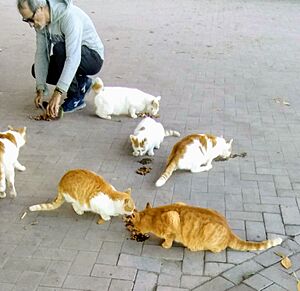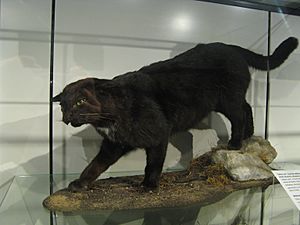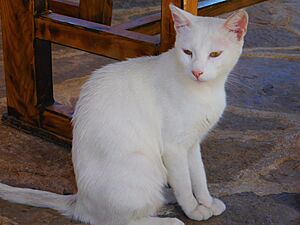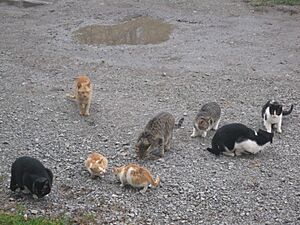Feral cat facts for kids
A feral cat or a stray cat is an unowned domestic cat (Felis catus) that lives outdoors and avoids human contact; it does not allow itself to be handled or touched, and usually remains hidden from humans. Feral cats may breed over dozens of generations and become an aggressive local apex predator in urban, savannah and bushland environments. Some feral cats may become more comfortable with people who regularly feed them, but even with long-term attempts at socialization, they usually remain aloof and are most active after dusk. Of the 700 million cats in the world, an estimated 480 million are feral.
Feral cats are devastating to wildlife, and conservation biologists consider them to be one of the worst invasive species on Earth. Attempts to control feral cat populations are widespread but generally of greatest impact within purpose-fenced reserves.
Some animal rights groups advocate trap-neuter-return programs to prevent the feral cats from continuing to breed. Scientific evidence has demonstrated that TNR is not effective at controlling feral cat populations.
Contents
Definitions

The meaning of the term feral cat varies between professions and countries, and is sometimes used interchangeably with other terms such as free-roaming, street, alley, or community cat. Some of these terms are also used to refer to stray cats, although stray and feral cats are generally considered to be different by rescuers, veterinarians, and researchers. The lines between stray and feral cat are diffuse. The general idea is that owned cats that wander away from their homes may become stray cats, and stray cats that have lived in the wild for some time may become feral.
Activists who seek to normalize feral cats in the environment are attempting to rebrand feral cats as community cats. Biologists say that this new term is euphemistic and distracts from feral cats being an environmental problem, and that it has connotations that falsely imply that feral cats exist with the consent of the communities where they live, and that the public has a moral obligation to support them in the outdoors. Studies have shown that the public does not support there being large numbers of free ranging cats in the outdoors, but that the use of language in surveys appears to influence the levels of support for different management options.
United Kingdom
In the United Kingdom, a feral cat is defined as a cat that chooses not to interact with humans, survives with or without human assistance, and hides or defends itself when trapped rather than allowing itself to be handled. Animal rescuers and veterinarians consider cats to be feral when they had not had much human contact particularly before eight weeks of age, avoid humans, and prefer to escape rather than attack a human. Feral cats are distinguished from domesticated cats based on their levels of socialization, ownership, and confinement, and on the amount of fear of, interaction with, and dependence upon humans. However, veterinarians and rescuers disagreed on whether a feral cat would tend to hiss and spit at or attack a human during an encounter, and disagreed on whether adult feral cats could potentially be tamed.
Italy

In Italy, feral cats have been protected since 1991, and it is illegal to kill them.
United States
A survey of rescue and veterinary facilities in the United States revealed that no widely accepted definition of a feral cat exists. Many facilities used waiting periods to evaluate whether a cat was feral by observing whether the cat became less afraid and evasive over time. Other indicators included the cat's response to touch with an inanimate object, and observation of the cats' social behavior in varying environments such as response to human contact, with a human nearby, or when moved to a quieter environment.
Australia
The Australian government categorizes cats who have no interaction with or assistance from humans as feral, and unowned cats who rely on humans as semi-feral or stray. However, even these so-called 'managed colonies' often have a devastating impact on wildlife as demonstrated in the decimation of native mammals in adjacent reserves, such as occurred with numbats and woylies in Western Australia.
Farm cat
A farm cat is a free-ranging domestic cat that lives in a cat colony on agricultural farms in a feral or semi-feral condition. Farm cats primarily live outdoors and usually shelter in barns. They are partially supplied with food and milk, but mainly subsist on hunting rodents such as black rat, brown rat, common vole and Apodemus species. In England, farm cat colonies are present on the majority of farms and consist of up to 30 cats. Female farm cats show allomothering behaviour; they use communal nests and take care of kittens of other colony members.
Some animal rescue organizations maintain Barn Cat Programs and rehome neutered feral cats to people who are looking for barn cats.
Ship's cat
Domestic cats have been members of ship crews since the beginning of commercial navigation. Phoenician and Etruscan traders probably carried cats on board their trading vessels to Italy and the Mediterranean islands.
History
Cats in ancient Egypt were venerated for killing rodents and venomous snakes. The need to keep rodents from consuming or contaminating grain crops stored for later human consumption may be the original reason that cats were domesticated. The spread of cats throughout much of the world is thought to have originated in Egypt. Scientists do not agree on whether cats were domesticated in Ancient Egypt or introduced there after domestication. Phoenician traders brought them to Europe for control of rat populations, and monks brought them further into Asia. Roman armies also contributed spreading cats and eventually brought them to Britain. Since then, cats continued to be introduced to new countries, often by sailors or settlers. Cats are thought to have been introduced to Australia in either the 1600s by Dutch shipwrecks, or the late 1700s by English settlers. These domesticated cats began to form feral populations after their offspring began living away from human contact.
In the 19th and 20th centuries, several cat specimens were described as wildcat subspecies that are considered feral cat populations today:
- Felis silvestris sarda, proposed by Fernand Lataste in 1885, was a skin and a skull of a male cat from Sarrabus in Sardinia that looked like an African wildcat (Felis lybica), but was more reddish, gray and brown and had longer hair on the back. In the 1980s, Colin Groves assessed values of Schauenberg's index of cat skulls of zoological specimens that originated in the Mediterranean islands. Based on these values, he concluded that Sardinian wildcats are descendants of African wildcats that were introduced from North Africa's Maghreb region. Results of zooarchaeological research indicate that Sardinian wildcats descended from domestic cats that were introduced during the Roman Empire, and probably originated in the Near East.
- Felis reyi, proposed by Louis Lavauden in 1929, was a skin and a skull of a specimen from Biguglia in Corsica that was smaller and darker than the European wildcat (Felis silvestris), had a much shorter tail than the African wildcat, and differed in fur colour and markings from both. When Reginald Innes Pocock reviewed Felis skins in the collection of the Natural History Museum, London, he considered Felis reyi a synonym of Felis lybica sarda, the Sardinian wild cat. The Corsican wildcat is considered to have been introduced in the early first millennium. The earliest known fossil records of cats date to the early 14th century, but older chronostratigraphic layers revealed fossils of livestock introduced since the Iron Age.
- Felis lybica jordansi, proposed by Ernst Schwarz in 1930, was a skull and skin of a male specimen from Santa Margarita in Mallorca that had more pronounced stripes than the African wildcat. This is also considered to have descended from domestic cats introduced to the island.
- Felis silvestris cretensis, proposed by Theodor Haltenorth in 1953, was a cat skin purchased in a bazaar in Chania that resembled an African wildcat, but had a bushy tail like a European wildcat. Groves considered the Cretan wildcat an introduced feral cat.
Distribution and habitat
The feral cat is the most widely distributed terrestrial carnivore. It occurs between 55° North and 54.3° South latitudes in a wide range of climatic zones and islands in the Atlantic, Indian and Pacific Oceans, and the Mediterranean Sea, including Canary Islands, Port-Cros, Dassen Island, Marion Island, Juan de Nova Island, Réunion, Hahajima, Okinawa Island, Raoul Island, Herekopare Island, Stewart Island, Macquarie Island, Galápagos Islands, San Clemente Island, Isla Natividad, San José Island, and New Island. Feral cat colonies also occur on the Japanese islands of Ainoshima, Hahajima and Aoshima, Ehime. The feral cat population on the Hawaiian Islands is mainly of European origin and probably arrived in the 19th century on ships.
Feral cat colonies in Rome have been monitored since 1991. Urban feral cats were studied in Madrid, Jerusalem and Ottawa.
Behavior and ecology
Some behaviors of feral cats are commonly observed, although there is disagreement among veterinarians, rescuers and researchers on the prevalence of some. In a free-roaming environment, feral cats avoid humans. They do not allow themselves to be handled or touched by humans, and back away or run when they are able to do so. If trapped, they hiss, growl, bare their teeth, or strike out. They remain fairly hidden from humans and will not approach, although some feral cats gradually become more comfortable around humans who feed them regularly.
Most feral cats have small home ranges, although some are more transient and travel long distances. The home ranges of male feral cats, which are generally two or three times larger than those of female cats, are on average under 10 ha (25 acres), but can vary from almost 300 ha (740 acres) to under 1 ha (2.5 acres). This variance is often due to breeding season, access to females, whether the cat is neutered, age, time of day, and availability of prey.
Feral cats depend on the presence of human settlement to subsist. Colonies and stray feral cats will settle in urban, suburban, and rural developments like cities and farms, wherever they can find easy access to food or prey animals. Few to no feral cats are found significantly distant from human settlements. While feral cats prey on other small mammals and reptiles, their home ranges don't change to reflect the seasonal availability of prey animals. This indicates that feral cats have a fairly consistent home range, and migration is more representative of mate availability, consistency in human-related food sources, or other less transient stimuli.
Colonies
Feral cats often live in groups called colonies, which are located close to food sources and shelter. Researchers disagree on the existence, extent, and structure of dominance hierarchies among feral cats in colonies. Different types of hierarchies have been observed in colonies, including despotic and linear hierarchies. Some colonies are organized in more complex structures, such as relative hierarchies, where social status of individual cats varies with location, time of day, or the activity the cats are engaged in, particularly feeding and mating.
A 'managed colony' is taken care of by humans who supply food and water to the cats, provide shelters and veterinary care, implement trap-neuter-return programs, find foster homes for cats that can be socialized for eventual adoption, and educate people in the neighborhood.
Feral cats are known to move from colony to colony when home ranges overlap. Additionally, colony populations fluctuate as cats leave family homes and some feral and semi-feral cats get socialized to home life and become family pets.
Socialization
Feral kittens can be trapped and socialized, then adopted into a home. The age at which a kitten becomes difficult to socialize is not agreed upon, but suggestions generally range from seven weeks to four months of age. Although older cats can sometimes be socialized, it is a very long and difficult process, and the cat rarely becomes friendly and may remain fearful.
In a 2013 study with British participants, rescuers tended to be more willing than veterinarians to attempt to tame adult feral cats. Veterinarians tended to be more opposed to this practice, with some expressing concerns for the welfare of such a cat in a home environment. In a 2010 interview survey with veterinarians and rescuers in the United States, 66% of respondents had socialization programs for kittens, and 8% for adult cats.
In Parañaque, Philippines, netizens lauded the building of wooden cattery, "Cat Homes" for "Puspin" (Pusang Pinoy) or stray cats.
Diet
Feral cats are either mesopredators (mid-ranking predators) or apex predators (top predators) in local ecosystems. They prey on a wide variety of both vertebrates and invertebrates, and typically prefer smaller animals with body weights under 100 g (3.5 oz), particularly mammals, birds, and lizards. Their global prey spectrum encompasses over 1,000 species; the most commonly observed were the house mouse, European rabbit, black rat, house sparrow, and common blackbird. In Australia, they prey on introduced species like the European rabbit and house mouse, and on native rodents and marsupials, particularly the common ringtail possum.
In the United States some people advocate for feral cats as a means to control pigeons and invasive rodents like the house mouse and brown rat, although these cosmopolitan species co-evolved with cats in human-disturbed environments and so have an advantage over native rodents in evading cat predation. Studies in California showed that 67% of the mice killed by cats were native species, and that areas near feral cat colonies actually have larger house mouse populations, but fewer birds and native rodents.
Though cats usually hunt animals less than half their size, a feral cat in Australia was photographed preying on an adult pademelon of around the cat's weight at 4 kg (8.8 lb).
African feral cats have been observed directly pilfering milk from the elephant seal's teat.
Predators
Feral cats are prey of feral dogs, dingoes, coyotes, caracals and birds of prey.
Health
Life span and survival
Feral cats in managed colonies can live long lives. A number of cats in managed colonies in the United Kingdom died of old age.
A long-term study of a trap-neuter-return (TNR) program on a university campus in Central Florida found that, despite widespread concern about the welfare of free-roaming cats, 83% of the cats studied had been present for more than six years, with almost half first observed as adults of unknown age. The authors compared this result to a 1984 study that found the mean life span for domesticated cats was 7.1 years.
Disease
Types
Feral cats, like all cats, are susceptible to diseases and infections including rabies, bartonellosis, toxoplasmosis, feline panleukopenia virus, external and internal parasites, feline immunodeficiency virus (FIV), feline leukemia virus (FeLV), rickettsial diseases, ringworm, and feline respiratory disease complex (a group of respiratory illnesses including feline herpesvirus type 1, feline calicivirus, Chlamydophila felis, and Mycoplasma haemofelis).
Feline leukemia virus and feline immunodeficiency virus belong to the Retroviridae family, and both cause immunosuppression in cats, which can increase their susceptibility to other infections.
Transmission to humans
The Center for Disease Control and Prevention has warned about the rabies risk associated with feral cats. With 16% of people infected with rabies from exposure to rabid cats, cats have been the primary animals responsible for transmission of the virus to humans in the United States since the efforts to control rabies in dogs in the 1970s. In 2010, there were 303 rabid cats reported within the United States. Although some colony management programs involve administering rabies vaccines, the need to revaccinate every few years makes this challenging to maintain. Furthermore, lack of documentation can mean that contact with vaccinated feral cats may still require post-exposure treatment.
The study of feral cats on Prince Edward Island warned of "considerable zoonotic risk" for transmission of intestinal parasites. Although the authors noted that their study did not provide evidence for great risk associated with T. gondii in cats, they advised that the risk should still be considered, as the infection in humans can cause significant health problems, and cats who are not otherwise transmitting the infection can begin shedding the parasite in times of stress.
Effects on wildlife
In the United States, free-ranging cats kill one to four billion birds and six to 22 billion mammals annually.
In Australia, domestic cats were introduced in the 1800s to settlements that had developed near gold mining sites and farms as a pest control strategy to decimate rabbits, mice, and rats. Feral cats kill on average one million reptiles each day. It has been estimated that they kill more than 800 million mammals annually, of which 56 percent are native species.
Impact on prey species
To date, little scientific data is available to assess the impact of cat predation on prey populations outside of agricultural situations. Even well-fed domestic cats may hunt and kill, mainly catching small mammals, but also birds, reptiles, amphibians, fish, and invertebrates. Hunting by domestic cats may be contributing to the decline in the numbers of birds in urban areas, although the importance of this effect remains controversial. Feral cats can threaten native species with extinction. Controlling or eliminating the populations of the non-native cats can produce a rapid recovery in native animals.
Native species such as the New Zealand kākāpō and the Australian bettong tend to be more ecologically vulnerable and behaviorally "naive", when faced with predation by cats. Feral cats have had a major impact on these native species and have played a leading role in the endangerment and extinction of many species. In Hawaii's remote, mountainous areas, they destroy the nests of seabirds including Newell's shearwater (Puffinus newelli) and the Hawaiian petrel (Pterodroma sandwichensis).
In agricultural settings, cats can be effective at keeping mouse and rat populations low, but only if rodent harborage locations (such as tall grass) are kept under control. While cats are effective at preventing rodent population explosions, they are not effective for eliminating pre-existing severe infestations. In systems where wildlife is threatened by both predation by rats and cats, there are concerns that controlling cats could increase predation by rats, due to rat populations increasing. For example, in Christmas Island, it was shown that decreasing cat populations would improve the growth rate of a threatened bird, as long as rats did not increase by more than 77 rats per cat removed.
Hybridisation with wildcats

Feral cats have interbred with wildcats to various extents throughout the world, the first reported case occurring more than 200 years ago. The significance of hybridisation is disputed. Modern genetic analysis revealed that the African wildcat is the ancestor of the domestic cat.
Pure Scottish wildcats are unlikely to exist, but the current wildcat population is distinct enough from domestic cats to be worth protecting. High levels of hybridisation have led to difficulties in distinguishing pure wildcats from feral and domestic cats, which can complicate conservation efforts. Trap-neuter-return programs have been established to prevent hybridisation.
Notable gene introgression into European wildcat populations exists also in Italy, Hungary, Spain and Portugal.
See also
 In Spanish: Gato cimarrón para niños
In Spanish: Gato cimarrón para niños





